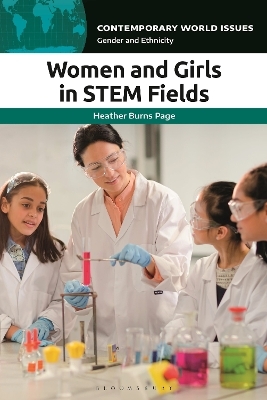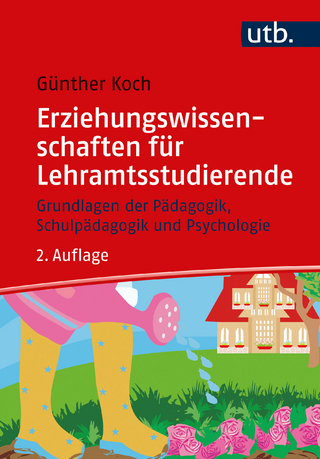
Women and Girls in STEM Fields
Bloomsbury Academic (Verlag)
978-1-4408-7990-6 (ISBN)
Since the passage of Title IX, the numbers of American women working in STEM fields have increased, particularly in the social and biological sciences. Nonetheless, women continue to be underrepresented in STEM disciplines, accounting for less than a third of the current STEM workforce. When the intersection of sociocultural factors such as race, ethnicity, and socioeconomic background are examined alongside gender, some demographic groups of women continue to lag in terms of representation in all STEM fields. The reasons cited for this continued state of affairs remain hotly debated, even as efforts intensify to break down longstanding gender barriers and bring women and girls into the worlds of science, technology, engineering, and mathematics.
Women and Girls in STEM Fields provides wide-ranging, complementary coverage of every aspect of the issue, from the historical barriers that confronted generations of American women and girls interested in pursuing careers in various STEM disciplines to the laws and movements that dismantle some of those obstacles. Features include smartly organized chapters on major trends, issues, debates, and historical moments; carefully selected profiles of the key organizations and individuals that have shaped discussions of this subject in Washington, D.C. and across the USA; a suite of original essays from educators, scholars, and women writing about their firsthand experiences in today's STEM world.
Heather Burns Page has over twenty-four years of experience as a science educator and school leader in the New York City public schools and is the principal of a public IB World School in Queens. Heather earned her doctorate in science education from New York University, her research centered on developing teaching resources to encourage girls in science. As a recipient of the 2015 New York Times “Teachers Who Make a Difference” award, she strives to prepare students to be global citizens and environmental stewards who work to better themselves, their community, and the environment. Heather loves to explore nature through travel and has taken students to Eastern and Western Europe, South Pacific, Central and South America. Heather completed two global study programs in Africa with New York University and circumnavigated Iceland as a 2016 Grosvenor Teacher Fellow in collaboration with National Geographic.
1 BACKGROUND AND HISTORY
History of Women and Girls in STEM
Girls and STEM Education in the United States
Feminism and the Movement to Elevate Girls and Women in STEM
Policy Response to Gender Disparities in STEM Education
The Importance of Title IX of the Education Amendments of 1972
STEM Workforce in Modern Society
Diversity of STEM Careers
Women and the STEM Workforce
Recent Increase in the STEM Workforce
Increasing Need for STEM and Girls’ and Women’s Voices in STEM
Background Needed for STEM Careers
Current State of Math and Science Education in the United States
Shortage of Qualified and Experienced Math and Science Teachers
Role of Career and Technical Education
Higher Education and STEM Careers
References
2 PROBLEMS, CONTROVERSIES, AND SOLUTIONS
Introduction
The STEM Gender Gap
STEM Participation Patterns in the United States
Global Participation Patterns in STEM
Implications of Women’s Low Participation in STEM
Lack of Talent, Innovation, and Creativity
Women’s Bodies and Experiences Not Considered in Research
Economic Loss for Women and Their Families
Notion of the Leaky STEM Pipeline
Prepared for STEM but Not Choosing STEM
Performance on STEM-Related Achievement Measures
Course Completion and Post-Secondary Degree Attainment
Girls’ Attitudes Towards STEM
Barriers to Girls’ Progress in STEM Education
Lack of Early Exposure to STEM
Presentation of STEM Subjects in School
Lack of Representation in STEM Curriculum
Gender Bias in School and Society
Barriers to Women’s Progress in STEM Careers
Lack of Role Models in STEM
Unfavorable Work Environments in STEM
Possible Solutions
Promote Awareness of Girls’ and Women’s Ability in STEM
Improve Elementary and Secondary STEM Education
Increase Access to Role Models in STEM
Improve STEM Work Environments
References
3 PERSPECTIVES
Introduction
Seeking Belonging and Flourishing for Girls in High School Mathematics
Dr. Kiran Purohit
Change the Story: Breaking Barriers One Opportunity at a Time
Tia Singh
So You Think You Can Be an Engineer? The Mental Health Journey of a Latina STEM Major
Lilly Gonzalez
Women in STEM: A Community with Good Chemistry
Emily Costa
Following My Heart Led Me to the World of Beauty
Taylor Anderson Martin
You’re Not Alone!—Finding Social Support in Male-Dominated Fields
Dr. Kanan Patel-Coleman
The Problem with Telling Girls They Can Be Anything They Want When They Grow Up
Lauren Johnston
4 PROFILES
Organizations
American Association for the Advancement of Science (AAAS) IF/THEN Ambassadors
The American Association of University Women (AAUW)
Association for Women in Computing (AWC)
Association for Women in Science (AWIS)
Association for Women in Math (AWM)
Bridge to Enter Advanced Mathematics (BEAM)
Black Girls Code
Brookhaven Women in Science (BWIS)
Building Engineering & Science Talent (BEST)
Caucus for Women in Statistics
Committee on the Advancement of Women Chemists (COACh)
Committee on the Status of Women in Astronomy
Enhancing Diversity in Graduate Education (EDGE)
Girls Excelling in Math and Science (GEMS)
Girlstart
Girls Who Code (GWC)
Graduate Women in Science (GWIS)
I Am a Scientist
Latinas in STEM
National Girls Collaborative Project (NGCP)
National Math and Science Initiative (NMSI)
The Scientista Foundation Inc.
SEA Change
SHINE for Girls
SISTER
Society of Women Engineers (SWE)
1000 Girls, 1000 Futures
UNESCO Girls’ and Women’s Education in STEM
Women in Ocean Science
Women in STEM (WiSTEM)
People
Maria Gaetana Agnesi (1718-1799)
Frances Arnold (1956-)
Deborah Berebichez (1972-)
Elizabeth Blackwell (1821-1920)
Dana Bolles (1969-)
Rachel Carson (1907-1964)
Mary Cartwright (1900-1998)
Marie Curie (1867-1934)
Marie M. Daly (1921-2003)
Ana Roqué de Duprey (1853-1933)
Émilie du Châtelet (1706-1749)
Sylvia A. Earle (1935-)
Enheduanna (2285-2250 BC)
Rosalind Franklin (1920-1958)
Sophie Germain (1776-1831)
Jane Goodall (1934-)
Euphemia Lofton Haynes (1890-1980)
Victoria Herrmann (1990-)
Grace Hopper (1906-1992)
Fern Hunt (1948-)
Hypatia (335-415 BC)
Mary Jackson (1921-2005)
Mae Jemison (1956-)
Katherine Johnson (1918-2020)
Lataisia Jones (1988-)
Susan La Flesche (1865-1905)
Aisha K. Lawrey (1977-)
Ada Lovelace (1815-1852)
Shirley Malcolm (1946-)
Barbara McClintock (1902-1992)
Lise Meitner (1878-1968)
Maria Mitchell (1818-1889)
Florence Nightingale (1820-1910)
Emmy Noether (1882-1935)
Antonia Novello (1944-)
Ellen Ochoa (1958-)
Sally Ride (1951-2012)
Julia Robinson (1919-1985)
Mary Golda Ross (1908-2008)
Reshma Saujani (1975-)
Florence Seibert (1897-1991)
Mary Somerville (1780-1872)
Chien-Shiung Wu (1912-1997)
Rae Wynn-Grant (1985-)
5. Data and Documents
Data
Table 5.1. National Assessment of Educational Progress (NAEP) STEM-related scores 2009-2019
Table 5.2 Trends in International Mathematics and Science Study (TIMSS) science and math scores for United States 2007-2019
Table 5.3 Programme for International Student Assessment (PISA) science and math scales for United States (students aged 15) 2009-2018
Figure 5.1 Undergraduate enrollment in science, technology, engineering, and mathematics (STEM) majors, Fall 2020
Table 5.4 Bachelor’s degrees awarded in science, technology, engineering and mathematics (STEM), 2011-2019
Table 5.5 Master's degrees awarded in science, technology, engineering and mathematics (STEM), 2011-2019
Table 5.6 Doctoral degrees awarded in science, technology, engineering and mathematics (STEM), 2011-2019
Figure 5.2 Science, technology, engineering and mathematics (STEM) workforce in the United States, 2019
Figure 5.3 Women in science, technology, engineering and mathematics (STEM) workforce in the United States 2019
Documents
“The Need of Women in Science,” Speech by Maria Mitchell (1876)
National Defense Education Act, Public Law 85-864 by U.S. Congress (1958)
Title IX of the Educational Amendments of 1972, Public Law 92-318 by U.S. Congress (1972)
“A Nation at Risk: The Imperative for Educational Reform,” Report of the United States National Commission on Excellence in Education (1983)
“We Must Ensure That Women’s Participation in Innovation Is Not the Exception, but Become the Norm,” Speech by Lakshmi Puri (2017)
“Achieving the Promise of a Diverse Workforce,” Testimony of Mae Jemison (2019)
Patsy T. Mink and Louise M. Slaughter Gender Equity in Education Act of 2021 (2021)
6. Resources
Books
Articles and Reports
Graphic Novels and Plays
Non-Print Resources
7. Chronology
Glossary
Index
About the Author
| Erscheinungsdatum | 05.10.2024 |
|---|---|
| Reihe/Serie | Contemporary World Issues |
| Verlagsort | London |
| Sprache | englisch |
| Maße | 152 x 229 mm |
| Themenwelt | Sozialwissenschaften ► Pädagogik ► Allgemeines / Lexika |
| Sozialwissenschaften ► Soziologie ► Gender Studies | |
| Wirtschaft | |
| ISBN-10 | 1-4408-7990-7 / 1440879907 |
| ISBN-13 | 978-1-4408-7990-6 / 9781440879906 |
| Zustand | Neuware |
| Haben Sie eine Frage zum Produkt? |
aus dem Bereich


